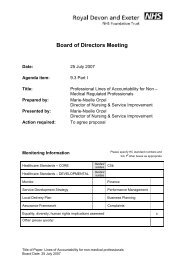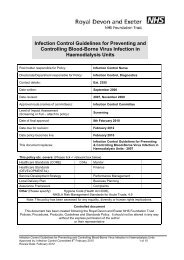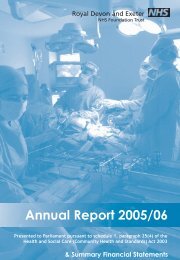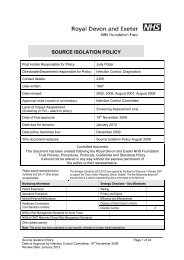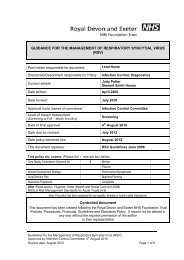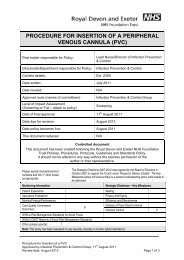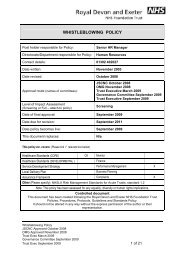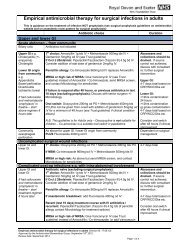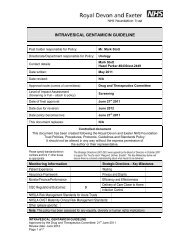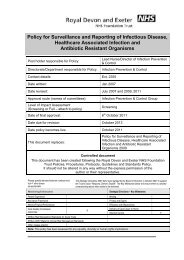Annual Report and Accounts 2012/13 - Royal Devon & Exeter Hospital
Annual Report and Accounts 2012/13 - Royal Devon & Exeter Hospital
Annual Report and Accounts 2012/13 - Royal Devon & Exeter Hospital
You also want an ePaper? Increase the reach of your titles
YUMPU automatically turns print PDFs into web optimized ePapers that Google loves.
68 4. Our Governance<br />
<strong>Royal</strong> <strong>Devon</strong> <strong>and</strong> <strong>Exeter</strong> NHS Foundation Trust<br />
<strong>Annual</strong> <strong>Report</strong> <strong>and</strong> <strong>Accounts</strong> <strong>2012</strong>/<strong>13</strong><br />
Our Governance<br />
The role of the Board<br />
of Directors<br />
The RD&E is a NHS Foundation<br />
Trust that is constituted as a public<br />
benefit corporation. Its governance<br />
structure is founded on a constitution<br />
that is approved by the regulator,<br />
Monitor. The constitution sets out<br />
how the organisation will operate<br />
from a governance perspective <strong>and</strong><br />
what arrangements it has in place,<br />
including its committee structures<br />
<strong>and</strong> procedures, to enable the Trust<br />
to be governed effectively <strong>and</strong> within<br />
the legislative framework. The Trust’s<br />
constitution incorporates the legal <strong>and</strong><br />
statutory requirements necessary to<br />
govern the Trust. In addition, Monitor<br />
has developed a Code of Governance<br />
which all Foundation Trusts must<br />
comply with (or explain if they<br />
choose not to comply). This details<br />
the necessary governance structures<br />
<strong>and</strong> processes that Foundation Trusts<br />
should have in place.<br />
Essentially, there are three basic<br />
components of the Trust’s governance<br />
structure:<br />
• The Membership<br />
• The Council of Governors<br />
• The Board of Directors.<br />
Members of the RD&E consist of<br />
members of the general public who<br />
choose to apply for membership,<br />
<strong>and</strong> Trust staff (unless they opt out).<br />
Members are located in a defined<br />
number of constituencies that are<br />
set out in the Trust’s constitution.<br />
Members elect Governors <strong>and</strong> can also<br />
st<strong>and</strong> for election themselves.<br />
The Council of Governors consists<br />
of elected public Governors, staff<br />
Governors <strong>and</strong> appointed individuals<br />
from key stakeholder organisations (as<br />
defined in the constitution). Governors<br />
help bind the Trust to its patients,<br />
service users, staff <strong>and</strong> stakeholders.<br />
Governors are unpaid <strong>and</strong> volunteer<br />
part-time on behalf of the Trust. They<br />
are not Directors <strong>and</strong> therefore do not<br />
act in a directorial capacity as their role<br />
is very different. The Trust Chairman is<br />
chair of both the Council of Governors<br />
<strong>and</strong> the Board of Directors.<br />
Governors are the direct representatives<br />
of local communities. They collectively<br />
challenge the Board of Directors <strong>and</strong><br />
hold them to account for the Trust’s<br />
performance, as well as representing<br />
the interests of Foundation Trust<br />
Members <strong>and</strong> the public <strong>and</strong> providing<br />
them with information on the Trust’s<br />
performance <strong>and</strong> forward plan.<br />
Governors have a range of statutory<br />
powers as well a significant influence<br />
over the Trust.<br />
The Board of Directors of the RD&E is<br />
ultimately <strong>and</strong> collectively responsible<br />
for all aspects of the performance of<br />
the Trust. The Board of Directors’ role<br />
is to:<br />
• Provide effective <strong>and</strong> proactive<br />
leadership of the Trust within a<br />
framework of processes<br />
• Develop procedures <strong>and</strong> controls<br />
which enable risk to be assessed<br />
<strong>and</strong> managed<br />
• Take responsibility for making sure<br />
the Trust complies with its terms<br />
of authorisation, its constitution,<br />
m<strong>and</strong>atory guidance issued<br />
by Monitor, relevant statutory<br />
requirements <strong>and</strong> contractual<br />
obligations<br />
• Set the Trust’s strategic aims<br />
at least annually, taking into<br />
consideration the views of the<br />
Council of Governors<br />
• Be responsible for ensuring the<br />
quality <strong>and</strong> safety of healthcare<br />
services, education, training <strong>and</strong><br />
research delivered by the Trust<br />
• Ensure that the Trust exercises its<br />
functions effectively, efficiently <strong>and</strong><br />
economically<br />
• Set the Trust’s vision, values <strong>and</strong><br />
st<strong>and</strong>ards of conduct <strong>and</strong> ensure<br />
the Trust meets its obligations to<br />
its members, patients <strong>and</strong> other<br />
stakeholders <strong>and</strong> communicates<br />
them to these people clearly<br />
• Take decisions objectively in the<br />
interests of the Trust<br />
• Take joint responsibility for every<br />
decision of the Board, regardless of<br />
their individual skills or status<br />
• Share accountability as a unitary<br />
Board<br />
• Constructively challenge the<br />
decisions of the Board <strong>and</strong> help<br />
develop proposals on priorities, risk<br />
mitigation, values, st<strong>and</strong>ards <strong>and</strong><br />
strategy.



